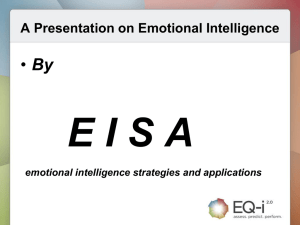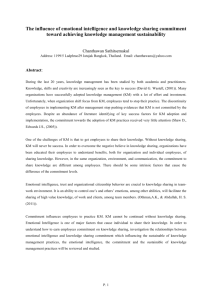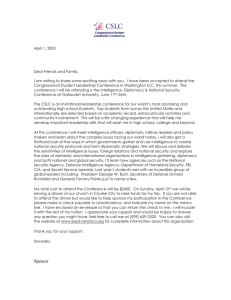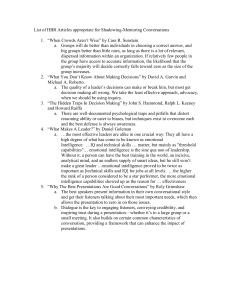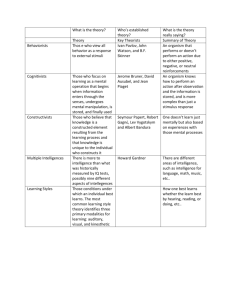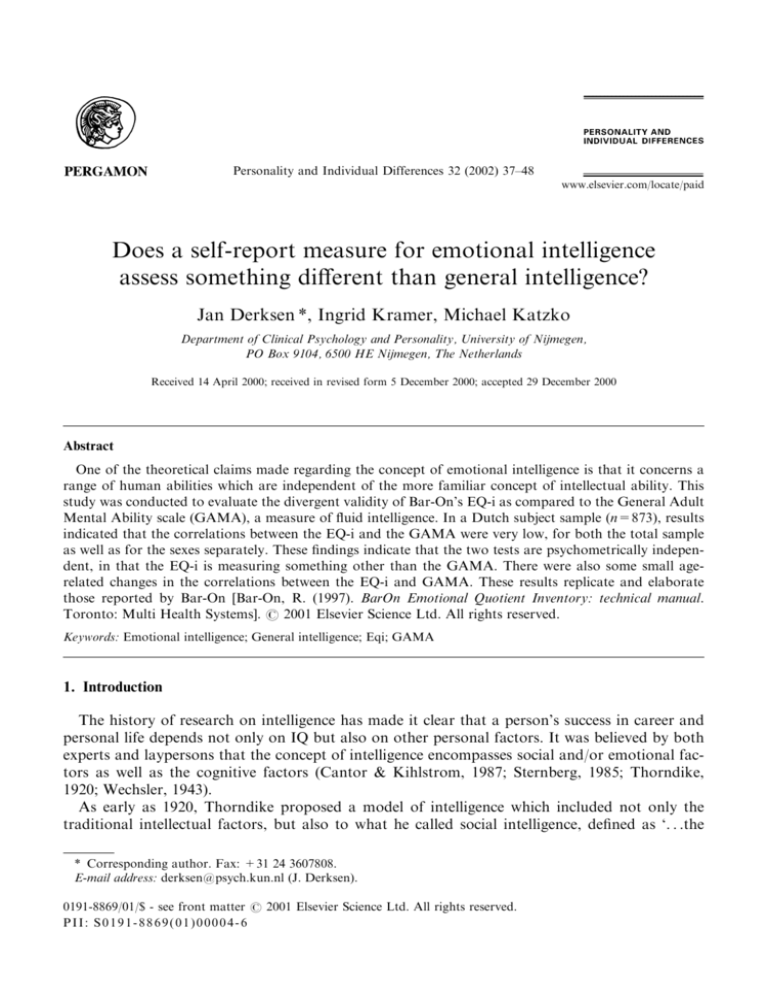
Personality and Individual Differences 32 (2002) 37±48
www.elsevier.com/locate/paid
Does a self-report measure for emotional intelligence
assess something dierent than general intelligence?
Jan Derksen *, Ingrid Kramer, Michael Katzko
Department of Clinical Psychology and Personality, University of Nijmegen,
PO Box 9104, 6500 HE Nijmegen, The Netherlands
Received 14 April 2000; received in revised form 5 December 2000; accepted 29 December 2000
Abstract
One of the theoretical claims made regarding the concept of emotional intelligence is that it concerns a
range of human abilities which are independent of the more familiar concept of intellectual ability. This
study was conducted to evaluate the divergent validity of Bar-On's EQ-i as compared to the General Adult
Mental Ability scale (GAMA), a measure of ¯uid intelligence. In a Dutch subject sample (n=873), results
indicated that the correlations between the EQ-i and the GAMA were very low, for both the total sample
as well as for the sexes separately. These ®ndings indicate that the two tests are psychometrically independent, in that the EQ-i is measuring something other than the GAMA. There were also some small agerelated changes in the correlations between the EQ-i and GAMA. These results replicate and elaborate
those reported by Bar-On [Bar-On, R. (1997). BarOn Emotional Quotient Inventory: technical manual.
Toronto: Multi Health Systems]. # 2001 Elsevier Science Ltd. All rights reserved.
Keywords: Emotional intelligence; General intelligence; Eqi; GAMA
1. Introduction
The history of research on intelligence has made it clear that a person's success in career and
personal life depends not only on IQ but also on other personal factors. It was believed by both
experts and laypersons that the concept of intelligence encompasses social and/or emotional factors as well as the cognitive factors (Cantor & Kihlstrom, 1987; Sternberg, 1985; Thorndike,
1920; Wechsler, 1943).
As early as 1920, Thorndike proposed a model of intelligence which included not only the
traditional intellectual factors, but also to what he called social intelligence, de®ned as `. . .the
* Corresponding author. Fax: +31 24 3607808.
E-mail address: derksen@psych.kun.nl (J. Derksen).
0191-8869/01/$ - see front matter # 2001 Elsevier Science Ltd. All rights reserved.
PII: S0191-8869(01)00004-6
38
J. Derksen et al. / Personality and Individual Dierences 32 (2002) 37±48
ability to understand and manage men and women, boys and girls Ð to act wisely in human
relations' (1920, p.228). Thorndike's de®nition of social intelligence has a cognitive and a behavioral component and implies the following. First, the ability to understand and manage people is
an intellectual capacity. Second, this capacity is dierent from the abstract-verbal and concretemechanical aspects of intelligence.
A great deal of attention has since been given to the concept of social intelligence. For years the
central question has been whether a unique empirically coherent domain of social intelligence
could be delineated, or whether social intelligence is only a function of a more general abstract
intelligence. Numerous studies were conducted to separate academic from social intelligence but
met with only moderate success (Brown & Anthony, 1990; Ford & Tisak, 1983). According to
Ford and Tisak (1983) most of these studies (e.g. Hoepfner & O'Sullivan, 1968; Keating, 1978;
Tenopyr, 1967; Thorndike & Stein, 1937; Walker & Foley, 1973) were unsuccessful for two reasons. First, it was dicult to de®ne social intelligence, with dierent researchers having dierent
de®nitions of the concept. Some de®nitions emphasized social perception or insight as the key to
social intelligence (Chapin, 1939; Walker & Foley, 1973), while others argued that social intelligence is a multidimensional construct (Cantor & Kihlstrom, 1987; Ford & Tisak, 1983; Jones &
Day, 1997; Marlowe, 1986; Mayer & Salovey, 1993; O'Sullivan & Guilford, 1975; Wong, Day,
Maxwell & Meara, 1995). The second problem has been how to measure social intelligence in a
psychometrically valid way. Social intelligence has been assessed by instruments that were
designed to measure ability to `understand others', e.g. social-cognitive skills rather than behaviorally oriented measures. Researchers who failed to separate the two forms of intelligence often
used social-cognitive measures in their study. However, it is essential to distinguish between the
cognitive and behavioral aspects of social intelligence (Ford & Tisak, 1983).
Given these problems with the concept of social intelligence, analysis turned to other ways of
conceptualizing and measuring non-academic intellectual factors. One alternative was the concept
of `emotional intelligence', ®rst introduced in 1990 by Salovey and Mayer, and popularized by
Goleman (1995). This concept has its roots in Wechsler's (1940, 1943) thought of `non-intellective
factors of general intelligence'. Leeper (1948) subsequently used this concept, assuming that
`emotional thoughts' are part of and contribute to `logical thought' and to intelligence in general.
Since then, there was no further work on emotional intelligence for about 40 years until Howard
Gardner (1983) developed his Multiple Intelligence Theory which combines cognitive with emotional aspects of intelligence. The Multiple Intelligence Theory consists of seven independent types of
intelligence, one of which is `Personal Intelligence'. Personal Intelligence can be divided into `Intrapersonal Intelligence', the knowledge of one's internal processes and feelings and `Interpersonal
Intelligence', the ability to determine other people's reactions, needs, emotions and intentions.
Salovey and Mayer (1990) de®ne emotional intelligence as a type of social intelligence which
involves the ability to monitor one's own and other's emotions, to discriminate among them, and
to use the information to guide one's thinking and actions. They distinguish six components of
emotional intelligence: emotional self-awareness, assertiveness, empathy, interpersonal relationships, stress tolerance and impulse control. These six components can also be found in Bar-On's
concept of emotional intelligence (Bar-On, 1997). Bar-On de®nes emotional intelligence as `an
array of noncognitive capabilities, competencies, and skills that in¯uence one's ability to succeed
in coping with environmental demands and pressures'. According to Bar-On, emotional intelligence is an important factor in determining one's ability to succeed in life and has a direct
J. Derksen et al. / Personality and Individual Dierences 32 (2002) 37±48
39
in¯uence on a person's general well-being. The need to empirically demonstrate the independence
of social from general intelligence is equally important for emotional intelligence. Bar-On developed the ®rst psychometrically researched test for emotional intelligence: the Emotional Intelligence inventory (EQ-i). In addition to the data in Bar-On's manual, Dawda and Hart (2000), did
a study of the reliability and validity of the EQ-i and were in favour of the further development of
the instrument. They also recommended strategies for further validation. Bar-On investigated the
divergent validity of emotional intelligence in relation to IQ and found a low correlation (r=0.12)
in a sample of 40 North-American persons who completed both the EQ-i and the Wechsler Adult
Intelligence Scale (WAIS; Wechsler, 1958). However, this result is less than convincing both
because of the small sample size and because, in measuring general intelligence by means of the
WAIS, one assesses not only the g-factor but also verbal aspects of intelligence, which can for a
large part be contributed to culture and education.
The present study was designed to correct these shortcomings. In so doing, we hope to
demonstrate the independence of emotional intelligence from general, g-factor intelligence.
2. Method
2.1. Participants
All subjects voluntarily participated in this study, after being approached by a data-collecting
agency (CenterData Tilburg). The subjects were representative of the Dutch population regarding
age, SES, urbanization, social relations, professional status and educational background. However, the age analyses reported in this study use the age-groups de®nitions of Naglieri and Bardos
(1997) in the development of the GAMA, and so the age distributions in these groups cannot be
considered representative of the Dutch population.
Of the original 1633 subjects who completed the EQ-i for norming purposes, 873 (489 men and
384 women) agreed to also complete the GAMA. Subjects were 19±84 years of age (M=50.74
years, S.D.=14.50 years).
2.2. Measures
The EQ-i is a self-report emotional intelligence questionnaire developed by Bar-On (1997). It
consists of 133 items and employs a ®ve-point response scale (ranging from `Not true of me' to
`True of me'), and can be completed within 30±40 min. However, there is no imposed time limit.
The assessment renders four validity scale scores, a total EQ score, ®ve composite scale scores
and 15 EQ subscale scores (Table 1). EQ-i raw scores are transformed into standard scores based
on a mean of `100' and a standard deviation of 15 (similar to IQ scores).
Subjects completed the Dutch translation of the EQ-i (Derksen, 1998); the items of the original
EQ-i were translated from English into Dutch by three psychologists independently (Derksen,
Jeuken & Klein-Herenbrink, 1998). In consultation with the test author, these translations were
integrated into a provisional Dutch version of the EQ-i. This was back-translated by a bilingual
native English speaker, which resulted in a number of additional revisions. A group of 31 Dutch
students in the ®nal phase of study of the English language (mean age: 23 years) completed both
40
J. Derksen et al. / Personality and Individual Dierences 32 (2002) 37±48
Table 1
The components and sub-scales of the EQ-i
Intrapersonal components
Emotional Self-Awareness
Assertiveness
Self-Regard
Self-Actualization
Independence
Adaptability components
Problem solving
Reality testing
Flexability
Interpersonal components
Empathy
Social Responsibility
Interpersonal Relationships
Stress Management components
Stress Tolerance
Impulse Control
General Mood components:
Optimism
Happiness
English and Dutch versions of the EQ-i in a quasi experimental counterbalanced within-subjects
ABBA design, one half of the group ®lled in the Dutch version ®rst and 3 weeks later the English
version. Analyses suggested that ®ve items could be further revised. No dierences on the scale
level were found.
Subjects completed the Dutch version of the General Adult Mental Ability scale (GAMA)
(Naglieri & Bardos, 1997). The GAMA is a non-verbal measure of general intelligence, which is
independent of verbal factors both in content and instruction. The GAMA was constructed to
measure ¯uid-intelligence and consists of 66 items organized into four item types: Matching,
Analogies, Sequences and Construction. Each item has a response set of ®ve possibilities. Test
results include a total IQ score with a mean of 100 and a standard deviation of 15. The GAMA
must be completed within a time limit of 25 min.
Subjects also completed a list of demographic questions, and four questions assessing self-perceived success. These data were collected to evaluate the construct and predictive validity if the
EQ-i, and will be analyzed and reported in a separate article.
3. Results
The relationship between the EQ-i total and component scale scores and the GAMA total and
subscale scores was assessed by computing Pearson-correlations between the two tests for the
total sample and the separate sexes. Age-related relationships between the two instruments were
also examined.
3.1. Relationship between EQ-i and GAMA
Table 2 presents the correlations between the EQ-i total and component scores and the GAMA
total and subscale scores. All correlations between the two instruments were very low and, where
statistically signi®cant, never accounted for more than 2% of the total variance. In interpreting
J. Derksen et al. / Personality and Individual Dierences 32 (2002) 37±48
41
such correlations, one must not forget that the signi®cance level indicates the statistical replicability of the magnitude of a ®nding, given a certain sample size. The absolute magnitude of r is
of greater theoretical importance than the statistical signi®cance as such.
It is also worth mentioning the low correlation between the Problem Solving subscale and the
GAMA (r=0.061, P<0.07), considering the importance which problem solving ability has in
both the theoretical and operational conception of general intelligence. This indicates that emotional problem solving, as measured by the EQ-i, is a dierent capacity than intellectual problem
solving as measured by the GAMA.
Separate analyses on male and female subsamples revealed a similar pattern of very low correlations between the EQ-i and the GAMA (Tables 3 and 4). A signi®cant correlation between
total IQ and the Stress Management component was found in both sexes (males, r=0.102,
P<0.05; females, r=0.163, P<0.01). There was also a statistically signi®cant correlation between
IQ and General Mood component among males (r=0.124, p<0.01), and between IQ and the
Adaptability component among females (r=124, p<0.05).
The sex dierences on the EQ-i reported by Bar-On (1997) were also replicated in our sample:
no signi®cant dierences between the mean scores on total EQ-i and the General Mood component, and signi®cant dierences between the mean scores on the Interpersonal, Intrapersonal,
Adaptability, and Stress Management components.
Table 2
Intercorrelations between the IQ total and scale scores and the EQ-i total and component scales for the total samplea
Total sample n=873
IQ
M=99.29
S.D.=14.73
Matching
M=99.95
S.D.=14.95
Analogy
M=99.47
S.D.=14.90
Sequences
M=99.17
S.D.=14.56
Construction
M=99.32
S.D.=14.72
EQ
M=100.89 S.D.=14.93
0.081*
0.058
0.045
0.075*
0.089**
Intrapersonal
M=100.51 S.D.=15.06
0.065
0.020
0.029
0.070*
0.082
Interpersonal
M=100.67 S.D.=14.64
0.043
0.009
0.063
0.044
0.025
Adaptability
M=100.80 S.D.=14.85
0.105**
0.062
0.080
0.094**
0.100**
Stress
M=100.68 S.D.=14.91
0.134**
0.110**
0.111**
0.112**
0.114**
General Mood
M=101.22 S.D.=14.71
0.109**
0.071*
0.071*
0.100**
0.112**
a
M, mean score; S.D., standard deviation; EQ, Emotional Quotient; Intrapersonal, Intrapersonal components;
Interpersonal, Interpersonal components; Adaptability, Adaptability components; Stress, Stress Management components; General Mood, General Mood components.
*P<0.05.
**P<0.01.
42
J. Derksen et al. / Personality and Individual Dierences 32 (2002) 37±48
3.2. Age-related eects
3.2.1. Relation between EQ-i and age
Bar-On (1997) reported that the total EQ-i increases with age, using 10-year intervals up to 50
years of age. In our own sample, we were able to examine the relation between age and the EQ-i
in greater detail, particularly at age groups above 50. The total sample was divided into age
categories used in the GAMA, and the means for the total EQ-i and component scales are plotted
in Fig. 1 (six subjects under 20 years of age are omitted). Separate one-way ANOVAs with
polynomial analysis were performed on the total and composite scale scores. Signi®cant quadratic
eects were found for the total and component scale scores, except for General Mood, where
there was a decreasing linear trend with age. These results can be summarized as indicating that
EQ-i scores peaks in the 35±44 age interval, and then decreases in old age. Dierent component
scales dier somewhat from this pattern, primarily in terms of the rate of increase and/or decease
with age. These ®ndings are also interesting in that the age-related changes in EQ-i are dierent
from that of the GAMA, where there is a decrease in IQ to about 60 years of age (Fig. 1). This
implies that dierent psychological factors underlie performance on these instruments.
3.2.2. related changes in correlations between EQ-i and GAMA
In contrast to the above results, where the correlations between the EQ-i and GAMA were
uniformly low, we begin to ®nd correlations of higher magnitude once dierent age groups are
examined. However, the correlations remain moderate at best. A plot of the correlation coecients
Table 3
Intercorrelations between the IQ total and scale scores and the EQ-i total and component scales for mena
Men n= 489
IQ
M=99.89
S.D.=14.97
Matching
M=99.56
S.D.=15.00
Analogy
M=99.74
S.D.=15.20
Sequences
M=99.92
S.D.=14.80
Construction
M=100.28
S.D.=15.03
EQ
M=101.75 S.D.=14.99
0.066
0.028
0.039
0.061
0.079
Intrapersonal
M=101.73 S.D.=14.73
0.067
0.002
0.044
0.063
0.091*
Interpersonal
M=97.71 S.D.=14.87
0.066
0.015
0.096*
0.059
0.030
Adaptability
M=102.40 S.D.=14.97
0.083
0.040
0.063
0.074
0.085
Stress
M=103.43 S.D.=14.82
0.102*
0.068
0.105*
0.101*
0.054
General Mood
M=102.06 S.D.=14.32
0.124**
0.052
0.085
0.113*
0.141**
a
M, mean score; S.D., standard deviation; EQ, Emotional Quotient; Intrapersonal, Intrapersonal components;
Interpersonal, Interpersonal components; Adaptability, Adaptability components; Stress, stress management components; General Mood, General Mood components.
*P<0.05.
**P<0.01.
J. Derksen et al. / Personality and Individual Dierences 32 (2002) 37±48
43
between total IQ and the EQ-i total and component scale scores for the separate age groups is
given in Fig. 2. Signi®cant correlations were found for Stress Tolerance at 25±34 and 70±74 years,
Interpersonal Relations at 35±44 and 55±59 years, and for all correlations at 65±69 years except
Interpersonal Relations. As with the correlations reported above, the signi®cance level is
obviously in¯uenced by the sample size. Thus, the absolute size of a correlation coecient may be
the same for two dierent groups, but only signi®cant for the larger sample. This does present
some problems regarding the con®dence with which the results can be interpreted. Nonetheless,
viewed purely as hypotheses, the following two generalisations can be suggested. First, the
Interpersonal component scale behaves in a strikingly dierent way than the other components of
the EQ-i, in that it consistently correlates negatively with IQ. Second, the correlations between
total EQ and the other component scales with IQ decrease in magnitude to the 35±44 age interval,
and then begin to increase in older age.
4. Discussion
4.1. Divergent validity of EQ-i and GAMA
The main purpose of this study was to assess the divergent validity of the EQ-I against the
GAMA, a measure of ¯uid intelligence. All results are strong indicators of the psychometric
Table 4
Intercorrelations between the IQ total and scale scores and the EQ-i total and component scales for womena
Women n=384
IQ
M=98.53
S.D.=14.39
Matching
M=100.44
S.D.=14.89
EQ
M=99.80 S.D.=14.80
0.095
0.100*
Intrapersonal
M=98.96 S.D.=15.35
0.054
Interpersonal
M=104.44 S.D.=13.45
Analogy
M=99.13
S.D.=14.51
Sequences
M=98.22
S.D.=14.22
Construction
M=98.09
S.D.=14.24
0.049
0.0855
0.092
0.049
0.005
0.070
0.057
0.014
0.028
0.008
0.010
0.024
Adaptability
M=98.76 S.D.=14.46
0.124*
0.101*
0.101*
0.107*
0.104*
Stress
M=97.17 S.D.=14.29
0.163**
0.186**
0.116*
0.103*
0.166**
General Mood
M=100.16 S.D.=15.13
0.084
0.098
0.051
0.075
0.066
a
M, mean score; S.D., standard deviation; EQ, Emotional Quotient; Intrapersonal, Intrapersonal components;
Interpersonal, Interpersonal components; Adaptability, Adaptability components; Stress, Stress Management components; General Mood, General Mood components.
*P<0.05.
**P<0.01.
44
J. Derksen et al. / Personality and Individual Dierences 32 (2002) 37±48
independence of the EQ-i from the GAMA. Not only are the correlations between the two
instruments consistently very low, the two instruments perform dierently across age. These
results are consistent with the interpretation that scores on the two instruments are a function of
dierent underlying constructs.
4.2. The problem of interpretation
A major problem in the area of psychological testing concerns maintaining a clear distinction
between the aims and purposes of an instrument in contrast to theories about how some type of
behavior is produced. The above results indicate that the EQ-i and the GAMA are not redundant: they provide independent information about the person completing the instruments. This
information may have some practical or predictive value under certain circumstances, but this
still needs to be established for the EQ-i.
At the same time, the changes in correlations between the two instruments across age hint at a
more complex process interpretation of how the underlying psychological constructs are interacting. One could speculate that the higher IQ±EQ correlations both early and later in life re¯ect
an acquisition and maintenance relation between general intelligence and emotional intelligence.
However, the correlations themselves give little clue to the workings of such processes, and this
Fig. 1. Mean standardized scores for GAMA-IQ and EQ-i total and component sclae scores.
J. Derksen et al. / Personality and Individual Dierences 32 (2002) 37±48
45
issue must be examined with further experimental research. Mayer and Salovey (1997) are working on an instrument which is intended to be a more direct measure of aptitude rather than being
dependent upon self-evaluation. Future discussions, in which more instruments are involved, will
clarify this issue further.
4.3. The problem of terminology
Given the low correlations between EQ and GAMA it is legitimate to ask whether the use of
the term `intelligence' is appropriate for the EQ-i and its' corresponding underlying construct. As
we suggested in the introduction, there are legitimate problems to be addressed. On the one hand,
there is the practical problem of how to develop good psychometric predictors of success generally as well as success in speci®c contexts. On the other hand, there is the more theoretical
concern for developing an adequate taxonomy of abilities in a broader sense. For example, it has
become apparent in educational settings that there are not only a wide range of distinct ability
domains, but that high performance in school settings in any domain is not simply a function of
competence in that domain (Katzko & MoÈnks, 1995). Given both these types of concerns, there
remains a terminological problem. The choice of the term `intelligence' may have been
unfortunate. In itself, it is possible to defend this in the context of the many dierent types of
Fig. 2. Correlations between GAMA-IQ total and the Eq-i total and component scale scores.
46
J. Derksen et al. / Personality and Individual Dierences 32 (2002) 37±48
intelligence and abilities that are currently dierentiated in the literature. However, this is still
terminologically inelegant and confusing. It might be better to emphasize a broad category of
human abilities and competencies within which a concept like `social competencies', or even
`emotional competencies', has its place alongside other types of cognitive competencies. This
might aid in putting the topic less in the spotlight of public opinion and more within the domain
of legitimate scienti®c inquiry.
4.4. Future research directions
The lack of a good, widely accepted de®nition and theory of emotional intelligence can lead to
circular reasoning, namely, interpreting the concept of emotional intelligence by the nature and
content of the speci®c test that was used. This pattern of reasoning is all too common in psychometric research, both in general and social intelligence as well as in other areas of personality.
What is still required is a good de®nition of emotional intelligence and a theory on a conceptual
level. Bar-On's instrument is a promising start in measuring `the non-intellectual factors of general intelligence' (Wechsler, 1940), but the model needs validation in several senses of that term.
An important problem of divergent validity concerns the relation between EQ and personality.
Many of the EQ-i scales tap capabilities like stress tolerance and assertiveness, but also attributes
like optimism and impulse control which seem to fall within the domain of `personality'. Some
preliminary results in our group suggest that the correlations with the NEO-PI-R are not as high
as one might expect, implying that emotional intelligence measured by the EQ-i is also not
equivalent to conventional personality traits. There is also the problem of interpreting correlations discussed above. Does a moderate correlation simply mean instrument redundancy? Or does
it have to do with overlapping construct validity?
Finally, one of the psychometric aims of the EQ-i was to be able to predict success generally or
in speci®c situations. But the notion of predictive validity must wrestle with both the conceptualization of the predictor instrument and the criterion behavior. One form of validation
research easy to administer is to correlate the EQ-i scores of people in comparable positions to
external indicators of success. Practically, the EQ-i must be able to distinguish between more and
less successful people in these respects. A more complicated and time-consuming option is prospective research in which people are tested and reassessed after 5 years time or more (Stankov, 1999) The main theoretical problem here concerns the nature of the construct and the
hypothesized way in which it contributes to `success'. For example, Newsome, Day and Catano (2000) assessed the predictive validity of the EQ-i against school achievement, and reported
that the instrument was no better than the 16PF in this regard. There may be other, non-academic,
situations where the predictive value of the instrument may perform better, but this still needs to be
established. Our research on smaller groups (Derksen, 1998) indicates that this might be true.
Acknowledgements
We are grateful to Pen Tests Publisher, the publishing company of the Dutch version of the
EQ-I and GAMA, for their support during the process of data collection.
J. Derksen et al. / Personality and Individual Dierences 32 (2002) 37±48
47
References
Bar-On, R. (1997). BarOn Emotional Quotient Inventory: technical manual. Toronto: Multi Health Systems.
Brown, L. T., & Anthony, R. G. (1990). Continuing the search for social intelligence. Personality and Individual Differences, 11, 463±470.
Cantor, N., & Kihlstrom, J. (1987). Personality and social intelligence. Englewood Clis, NJ: Prentice Hall.
Chapin, F. S. (1939). Social participation and social intelligence. American Sociological Review, 4, 157±166.
Dawda, D., & Hart, S. D. (2000). Assessing emotional intelligence: reliability and validity of the Bar-On Emotional
Quotient Inventory (EQ-i) in university students. Personality and Individual Dierences, 28, 797±812.
Derksen, J. J. L. (1998). EQ en IQ in Nederland. Nijmegen: Pen Test Publisher.
Derkeson, T. J. L., Jenken, J., & Klein-Herenbrink, A. J. M. (1998). Bar-On Emotional Quotient Vragenliijst. Nijmegen: PEN Psychodiagnostica Dutch translation and adaption.
Ford, M. E., & Tisak, M. S. (1983). A further search for social intelligence. Journal of Educational Psychology, 75, 196±
206.
Gardner, H. (1983). Frames of mind. New York: Basic Books.
Goleman, D. (1995). Emotional intelligence. New York: Bantam Books.
Hoepfner, R., & O'Sullivan, M. (1968). Social intelligence and IQ. Educational and Psychological Measurement, 28,
339±344.
Jones, K., & Day, J. D. (1997). Discrimination of two aspects of cognitive-social intelligence from academic intelligence. Journal of Educational psychology, 89, 486±497.
Katzko, M. W., & MoÈnks, F. J. (1995). Nurturing talent: individual needs and social ability. Assen: Van Gorcum.
Keating, D. P. (1978). A search for social intelligence. Journal of Educational Psychology, 70, 218±223.
Leeper, R. W. (1948). A motivational theory of emotions to replace `emotions as disorganised responses'. Psychological
Review, 55, 5±21.
Marlowe, H. A. (1986). Social intelligence: evidence for multidimensionality and construct independence. Journal of
Educational Psychology, 78, 52±58.
Mayer, J. D., & Salovey, P. (1993). The intelligence of emotional intelligence. Intelligence, 17(4), 433±442.
Mayer, J. D., & Salovey, P. (1997). Emotional intelligence test. Needham, Ma: Virtual Knowledge (producer and
Distributor, Cd-ROM).
Naglieri, J. A., & Bardos, A. N. (1997). GAMA (general ability measure for adults): manual. Minneapolis: National
Computer Systems.
Newsome, S., Day, A. L., & Catano, V. M. (2000). Assessing the predictive validity of emotional intelligence. Personality and Individual Dierences, 29, 1016±1055.
O'Sullivan, M., & Guilford, J. P. (1975). Six factors of behavioral cognition: understanding other people. Journal of
Educational Measurement, 12, 255±271.
Salovey, P., & Mayer, J. D. (1990). Emotional intelligence. Imagination, cognition and personality, 9(3), 185±211.
Stankov, L. (1999). Mining on the ``no man's land'' between intelligence and personality. In P. L. Ackerman, & P. C.
Kyllonen, Learning and individual dierences: process, trait and content determinants (pp. 315±337). Washington, DC:
American Psychological Association.
Sternberg, R. J. (1985). Beyond IQ. A triarchic theory of human intelligence. location: Cambridge University Press.
Tenopyr, M. L. (1967). Social intelligence and academic success. Educational and Psychological Measurement, 27, 961±
965.
Thorndike, R. L. (1920). Intelligence and its uses. Harper's Magazine, 140, 227±235.
Thorndike, R. L., & Stein, S. (1937). An evaluation of the attempts to measure social intelligence. The Psychological
Bulletin, 34, 275±284.
Walker, R. E., & Foley, J. M. (1973). Social intelligence: its history and measurement. Psychological Reports, 33, 839±
864.
Wechsler, D. (1940). Nonintellective factors in general intelligence. Psychological Bulletin, 37, 444±445.
Wechsler, D. (1943). Non-intellective factors in general intelligence. Journal of Abnormal and Social Psychology, 38,
101±103.
Wechsler, D. (1958). The measurement and appraisal of adult intelligence (4th ed.). Baltimore: Williams and Wilkins.
48
J. Derksen et al. / Personality and Individual Dierences 32 (2002) 37±48
Wong, C. T., Day, J. D., Maxwell, S. E., & Meara, N. M. (1995). A multitrait-multimethod study of academic and
social intelligence in college students. Journal of Educational Psychology, 87, 117±133.




